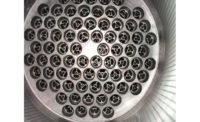When considering the “greenness” of your cooling tower selection, you
should investigate several green facets that will impact the
environment and your bottom line.
When considering the “greenness” of your cooling tower selection, you should investigate several green facets that will impact the environment and your bottom line.
With the examination of every product as to its "greenness," it has finally come to the ubiquitous cooling tower sitting atop just about every food and beverage manufacturing facility.
Greenness, of course, has several facets. And while the more advanced cooling towers are made of recyclable high-density polyethylene plastic cooling towers that will last for many decades, recyclability becomes a moot point. A more realistic examination of cooling tower greenness will deliberate improved sustainability, greater energy efficiency, added water conservation and smaller carbon footprint – plus some cost ramifications involved in achieving such green goals.
While conventional cooling towers, often constructed with basins lined with sheet metal cladding, are environmentally challenging and maintenance intensive – hence costly to operate – the alternative of using cooling towers with molded seamless plastic is immediately beneficial to both the environment and bottom line.
While the traditional, galvanized metal-clad cooling towers have done a good job at cooling process water, they also have been highly prone to corrosion and, therefore, frequent cleaning, re-coating and replacement. Additionally, metal cooling towers require extra caution when using water treatment chemicals to maintain continuous proper water chemistry to prevent accelerated loss of galvanizing leading to costly downtime and early replacement.
With the increasing concerns about meeting green standards and also improving return on investment on capital equipment expenditures, here are some criteria you should consider when evaluating your next cooling tower purchase:
Sustainability
In the broad sense, sustainability refers to the “carrying” capacity of the ecosystem in terms of resource consumption, including the ability – economically and environmentally - to meet present demands and yet still provide for future generations. With that definition in mind, the ultimate in cooling tower sustainability is a model that can outlast the building it services.
Traditional metal towers, which last only a few years in many applications, confront owners with environmental and economic issues including increased chemical use, higher maintenance costs, replacement costs and disposal requirements.
Conversely, unparalleled lifespan has been achieved by plastic cooling tower models that feature a seamless, molded HDPE shell, such as the one pioneered by Delta Cooling Towers, located in Rockaway, N.J. Backed by 15-year shell warranty, this non-corroding engineered-plastic design will not rust, corrode or require the downtime for service that traditional metal towers require. HDPE plastic eliminates disposal problems because the material may be ground and recycled into other sustainable products.
Green by design
Engineered HDPE plastic design allows seamless-shell water towers the most aggressive water treatment options available. This can allow users to run at higher cycles of concentration, thereby saving make-up water. These water and chemical savings can be very large and help solve water issues as well as save on operating costs.
With improved thermal performance, the counterflow designs such as Delta’s have less of an environmental impact than crossflow designs. Counterflow designs have much less water splash than crossflow models, especially during high winds or when fans are off at low-load or low wet-bulb conditions.
Cooling towers of this design also keep water totally enclosed and free from sunlight, thereby lessening the occasion for biological growth, which requires less harsh water treatment chemicals.
Counterflow models also can incorporate the industry’s best drift eliminators at .001% or even Delta’s optional .0005% of the re-circulating flow.
Energy efficiency
While the cost of electric power to drive cooling tower fans may seem incidental to process costs, they also can add up. Some manufacturers use direct-drive motors to power their cooling fans. (Delta was the first cooling tower manufacturer to standardize NEMA Premium Efficiency direct-drive motors.) With no pulleys, bearings and belts, direct-drive motors are more efficient and provide substantial savings in energy costs while also delivering more horsepower. When modular towers are incorporated into a multi-cell configuration, direct-drive tower motors or complete cells can be shut off independent of others when supported processes are not operating or heat load is low.
The efficiency of Delta’s high-performance design, which runs on less horsepower than comparable standard models, is reflected in the savings of electricity usage. For example, a three-cell TM model, using six five-horsepower premium efficiency motors running 8,760 hours annually costs an average of $10,570. Competitive models running four 15-horsepower “standard” motors for the same period would cost an annual average of $22,600 – over twice as much. Hence, a much lower carbon footprint.
U.S. Green Building Council LEED credits are available for buildings complying with American Society of Heating, Refrigeration and Air-Conditioning Engineers’ 90.1 minimum efficiency standards.
Recently adopted ASHRAE 90.1 standards established minimum efficiency standards for cooling towers with either axial or centrifugal fans. The minimum efficiency values are greater than 38.2 gpm/hp for axial fan cooling towers and 20.0 gpm/hp for centrifugal models at 95°F entering water, 85° leaving water and 75° wet bulb temperature. All Delta cooling tower models exceed these energy efficiency performance levels, thereby qualifying for LEED assessment credits.
High capacities
In the past, plastic cooling towers were too small for many industrial processes, making galvanized metal cooling towers virtually a “given” for most applications above 250 tons. Processors requiring high-capacity cooling were forced to build custom-designed towers on site, often at a high cost in labor and materials.
Today that situation has changed dramatically. Delta, for example, has introduced a series of factory-assembled plastic towers to suit almost any size requirements up to 2,000 cooling tons in a single, modularized unit.
For more information, contact Delta Cooling Towers, Inc., 41 Pine Street, Rockaway, NJ 07866; 800/BUY-DELTA (289-3358); Fax 973/586.2243; sales@deltacooling.com; or visit their Web site, www.deltacooling.com.
For more PR information, contact:
Michael LaPonza, Power PR
310/787-1940
press@powerpr.com
Green Cooling Towers
Looking for a reprint of this article?
From high-res PDFs to custom plaques, order your copy today!



